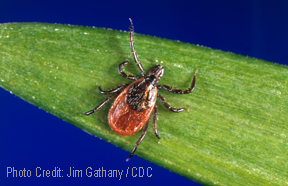What You Should Know About Lyme Disease
by Janice Rutkowski, M.D.
Lyme disease is caused by an organism which resides in deer ticks. The northeastern United States is a prevalent area for the disease, with over 20% of ticks affected. Lyme disease is most frequently seen in the summertime; and you do not have to go camping or hike in the woods to contract the disease; even gardening can expose you to the organism.
The northeastern United States is a prevalent area for the disease, with over 20% of ticks affected. Lyme disease is most frequently seen in the summertime; and you do not have to go camping or hike in the woods to contract the disease; even gardening can expose you to the organism.
The typical case of Lyme disease begins after an incubation period of 3 to 32 days with a red rash exhibited in 75% of individuals, though 25% have no sign of the illness. The rash starts as a flat red spot and expands to form a large round or oval lesion, sometimes with a bright red outer border and partial clearing in the center – this is the classic “bull’s eye lesion”. It’s usually not painful, but within days of the onset, the disease can spread in the bloodstream and cause severe headache, pain in joints and profound fatigue. These symptoms can resolve on their own within weeks without treatment, but can lead to meningitis, nerve disorders, chronic arthritis, and cardiac abnormalities.
The diagnosis of Lyme disease is made by a doctor’s exam and a blood test, though the blood tests are often negative. Treatment includes antibiotics and if diagnosed early, is curative. See your doctor immediately if you are concerned you have been bitten by an infected tick or show signs or symptoms indicative of Lyme disease.
To learn more about what to do after a tick bite to prevent Lyme disease click on this link courtesy of UpToDate.com: http://www.uptodate.com/contents/what-to-do-after-a-tick-bite-to-prevent-lyme-disease-beyond-the-basics
 Dr. Rutkowski is a Maryland Primary Care Physicians, LLC partner and is certified by the American Board of Internal Medicine. She received her medical degree from the University of Limoges in 1981 and completed her residency program in Internal Medicine at Maryland General Hospital in 1984.
Dr. Rutkowski is a Maryland Primary Care Physicians, LLC partner and is certified by the American Board of Internal Medicine. She received her medical degree from the University of Limoges in 1981 and completed her residency program in Internal Medicine at Maryland General Hospital in 1984.




